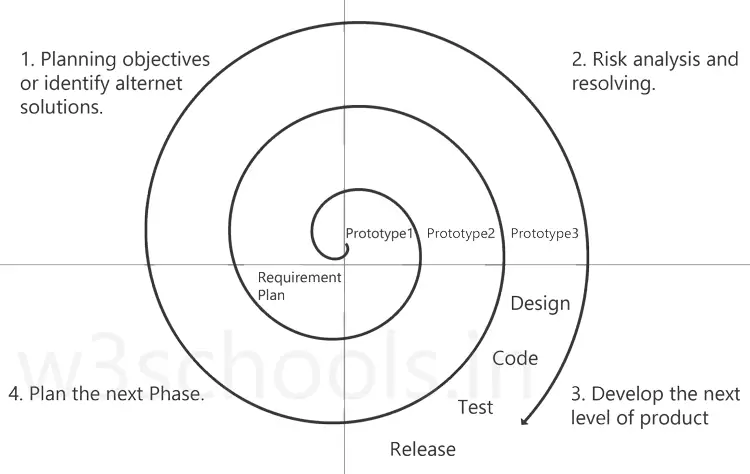The spiral model is another important SDLC model that came into use when the iteration in product development came into the applied concept. The initial phase of the Spiral model is the early stages of Waterfall Life Cycle that are needed to develop a software product. This model supports risk handling, and the project is delivered in loops. Each loop in the Spiral model is the phases of the software development process.
What is Spiral model?
The popular spiral model is a blend of both iterative development method as well as sequential improvement model, i.e., the waterfall model that is having exceptionally high importance on risk analysis. In this model, the exact number of phases for developing a product varied based on some constraints and by project manager which calculates the project risks. Here the project manager dynamically decides the number of phases and hence play a significant role in the development of a product using the spiral model. The radius in spiral usually shows the expenses or cost needed for project development. The angular dimension shows the development done to date during the recent phase.
Different Phases of the Spiral model
The phase of the spiral model has four quadrants, and each of them represents some specific stage of software development. The functions of these four quadrants are listed below:
- Planning objectives or identify alternative solutions: In this stage, requirements are collected from customers and then the aims are recognized, elaborated as well as analyzed at the beginning of developing the project. If the iterative round is more than one, then an alternative solution is proposed in the same quadrant.
- Risk analysis and resolving: As the process goes to the second quadrant, all likely solutions are sketched, and then the best solution among them gets select. Then the different types of risks linked with the chosen solution are recognized and resolved through the best possible approach. As the spiral goes to the end of this quadrant, a project prototype is put up for the most excellent and likely solution.
- Develop the next level of product: As the development progress goes to the third quadrant, the well-known and mostly required features are developed as well as verified with the testing methodologies. As this stage proceeds to the end of this third quadrant, new software or the next version of existing software is ready to deliver.
- Plan the next Phase: As the development process proceeds in the fourth quadrant, the customers appraise the developed version of the project and reports if any further changes are required. At last, planning for the subsequent phase is initiated.
Graphical Presentation of the Spiral Model

Advantages of the Spiral Model
The spiral model has some advantages compared to other SDLC models:
- Suitable for large projects: Spiral models are recommended when the project is large, bulky or complex to develop.
- Risk Handling: There are a lot of projects that have un-estimated risks involved with them. For such projects, the spiral model is the best SDLC model to pursue because it can analyze risk as well as handling risks at each phase of development.
- Customer Satisfaction: Customers can witness the development of product at every stage and thus, they can let themselves habituated with the system and throw feedbacks accordingly before the final product is made.
- Requirements flexibility: All the specific requirements needed at later stages can be included precisely if the development is done using this model.